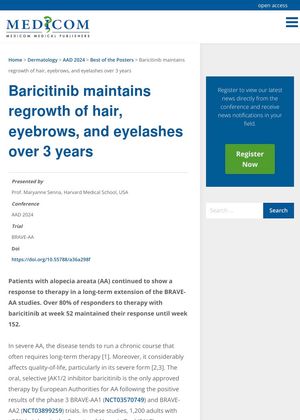TLDR Baricitinib helps keep hair, eyebrows, and eyelashes regrown for 3 years in most people with severe hair loss.
The long-term extension of the BRAVE-AA studies showed that over 80% of patients with alopecia areata (AA) who responded to baricitinib therapy at week 52 maintained their response until week 152. The studies involved 1,200 adults with ≥50% hair loss, who were given either 2 mg or 4 mg of baricitinib daily. After 3 years, 89.1% of participants treated with the high dose and 83.6% treated with the low dose maintained a Severity of Alopecia Tool (SALT) score ≤20. Additionally, the proportion of participants achieving full or nearly full eyebrows and eyelashes increased from week 52 through week 152. For the 4 mg group, 80% had full or nearly full eyebrows and 80.9% had full or nearly full eyelashes at week 152. For the 2 mg group, these percentages were 66.7% and 78.1% respectively.
 11 citations
,
January 2022 in “Journal der Deutschen Dermatologischen Gesellschaft”
11 citations
,
January 2022 in “Journal der Deutschen Dermatologischen Gesellschaft” Alopecia areata is a chronic condition causing hair loss, with new treatments targeting the immune system showing promise.
 128 citations
,
February 2016 in “British Journal of Dermatology”
128 citations
,
February 2016 in “British Journal of Dermatology” Alopecia areata significantly lowers the quality of life, especially in emotional and mental health aspects.
 May 2023 in “Journal of managed care & specialty pharmacy”
May 2023 in “Journal of managed care & specialty pharmacy” Alopecia areata causes hair loss and life quality issues; current treatments are often unsatisfactory, but new drugs like JAK inhibitors show promise.
 1 citations
,
September 2023 in “Journal of drugs in dermatology”
1 citations
,
September 2023 in “Journal of drugs in dermatology” Alopecia areata causes unpredictable hair loss and emotional distress, with no cure and limited treatment options.
 May 2023 in “Journal of Clinical Medicine”
May 2023 in “Journal of Clinical Medicine” New understanding and treatments for hair loss are improving, but more research is needed.
 July 2025 in “International Journal of Dermatology Venereology and Leprosy Sciences”
July 2025 in “International Journal of Dermatology Venereology and Leprosy Sciences” Higher stress levels may worsen alopecia areata, suggesting stress management is important for treatment.
 September 2025 in “Australasian Journal of Dermatology”
September 2025 in “Australasian Journal of Dermatology” New medications could improve treatment for severe alopecia areata in Australia.
 March 2022 in “Wound practice & research”
March 2022 in “Wound practice & research” New treatments for alopecia areata show promise, but standardized guidelines are needed.








